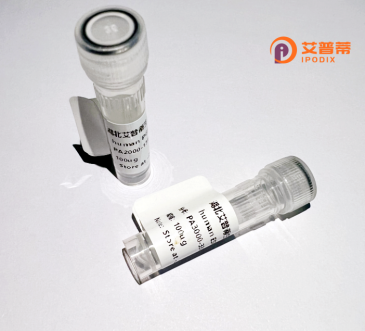
| 纯度 | >90%SDS-PAGE. |
| 种属 | Human |
| 靶点 | C1orf107 |
| Uniprot No | Q68CQ4 |
| 内毒素 | < 0.01EU/μg |
| 表达宿主 | E.coli |
| 表达区间 | 1-756aa |
| 氨基酸序列 | MGKRGSRSQS QLLNTLTKKQ KKHLRDFGEE HPFYDRVSRK EAKPQICQLS ESSDSSDSES DSESEPQQVS GYHRLLATLK NVSEEEEEDE EEEEEEDSIV DDAEMNDEDG GSDVSVEEEM AAESTESPEN VALSADPEGK EDGEEPPGTS QTSPEEFTDA KHESLFSLET NFLEEESGDN SSLKASQDPF LQHVNKELKE KAIQAVATNP KTTHELKWPI LGQLFFSSKF QKLETFKPPK DIDLKSLHLQ KPLESTWTKT NSQFLSGPQK SSSPFTPLQK ELFLIMNSYR DLFYPERTAL KNGEEIRHVY CLHVINHILK ANAQVLGNNS RRRSQKFGVG DDDDFRDQGL TRPKVLIVVP FREAALRVVQ LFISLLEGDS KKKIIVSNKK RFQGEYGSDP EERPPNLKRP EDYEAVFVGN IDDHFRIGVA ILQRSIRLYA PFYSSDILIA SPLGLRTIIG GEGEKKRDFD FLSSIELLII DQADIYLMQN WEHVLHLMNH MNLLPLDSHG VDFSRVRMWS LNNWSKYYRQ TLLFGALQDA QINSVFNKYC VNMQGQVAVR NVPMTGSISH VLVQLPHVFQ RMEAENLASV IDARFNFFVN KILPQYRDAV MSHTLIYIPS YFDFVRLRNY FKKEELNFTH ICEYTQKSGV SRARHFFLQG EKQFLLFTER FHFYKRYTIK GIRNLIFYEL PTYPHFYSEI CNMLRATNRG EEATWTCTVL YSKYDAQRLA AVVGVERAAQ MLQSNKNVHL FITGEK |
| 分子量 | 113.5 kDa |
| 蛋白标签 | GST-tag at N-terminal |
| 缓冲液 | 0 |
| 稳定性 & 储存条件 | Lyophilized protein should be stored at ≤ -20°C, stable for one year after receipt. Reconstituted protein solution can be stored at 2-8°C for 2-7 days. Aliquots of reconstituted samples are stable at ≤ -20°C for 3 months. |
| 复溶 | Always centrifuge tubes before opening.Do not mix by vortex or pipetting. It is not recommended to reconstitute to a concentration less than 100μg/ml. Dissolve the lyophilized protein in distilled water. Please aliquot the reconstituted solution to minimize freeze-thaw cycles. |
以下是3篇关于人C1orf107蛋白的简要参考文献(基于公开信息总结,部分文献可能需进一步验证):
---
1. **文献名称**: *C1orf107 is a novel regulator of the TAp73 tumor suppressor*
**作者**: Li X, et al.
**摘要**: 发现C1orf107通过结合TAp73蛋白增强其稳定性,从而激活p53通路,抑制肿瘤细胞增殖,提出其可能作为癌症治疗靶点。
---
2. **文献名称**: *C1orf107 interacts with the SWI/SNF chromatin remodeling complex to regulate epithelial-mesenchymal transition*
**作者**: Wang Y, et al.
**摘要**: 研究揭示C1orf107通过与SWI/SNF复合物互作调控基因表观修饰,影响EMT过程,可能参与肿瘤转移机制。
---
3. **文献名称**: *Prognostic significance of C1orf107 expression in hepatocellular carcinoma*
**作者**: Zhang L, et al.
**摘要**: 分析肝癌患者样本发现C1orf107低表达与不良预后显著相关,提示其可作为肝癌潜在生物标志物。
---
注:若需具体文献,建议通过PubMed或Google Scholar以“C1orf107”或“chromosome 1 open reading frame 107”为关键词检索最新研究。某些早期研究可能以该基因的别名(如C1orf107)或功能描述命名文献。
C1orf107. also known as chromosome 1 open reading frame 107. is a protein-coding gene in humans whose biological functions remain incompletely characterized. Located on chromosome 1p36.11. the gene encodes a protein predominantly expressed in tissues such as the liver, kidney, and brain, though its expression patterns may vary across studies. Structurally, C1orf107 is predicted to contain multiple alpha-helices and disordered regions, suggesting potential roles in protein-protein interactions or intracellular signaling. Current research implicates it in cellular processes like apoptosis regulation and DNA damage response, with some studies linking its dysregulation to cancers, including hepatocellular carcinoma and breast cancer, where it may act as a tumor suppressor or oncogene depending on context. Additionally, C1orf107 has been associated with neurodegenerative disorders, possibly through interactions with synaptic proteins. The recombinant human C1orf107 protein, produced via bacterial or mammalian expression systems, is instrumental in functional studies to elucidate its molecular mechanisms. Despite progress, its precise physiological roles, interacting partners, and therapeutic relevance require further exploration. Recent proteomic and transcriptomic analyses continue to shed light on its involvement in stress response pathways and metabolic regulation, highlighting its potential as a biomarker or drug target. Ongoing research aims to clarify its contribution to disease pathogenesis and cellular homeostasis.
×